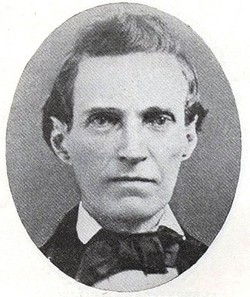Orson Spencer facts for kids
Quick facts for kids
Orson Spencer
|
|
|---|---|
 |
|
| Born | March 14, 1802 |
| Died | October 15, 1855 (aged 53) |
Orson Spencer (born March 14, 1802 – died October 15, 1855) was an important writer and leader in The Church of Jesus Christ of Latter-day Saints. He held many important jobs in the church and wrote a lot about his faith. He is known as one of the highly educated people who joined the Church during the time of Joseph Smith.
Contents
Early Life and Education
Orson Spencer was born in West Stockbridge, Massachusetts. People thought he was a very smart boy. When he was 12, he got a fever that almost killed him. It left him with a limp, meaning he walked with a slight difficulty.
At age 15, the town sheriff was so impressed by Orson that he offered to pay for his education. Orson then started studying at Lenox Academy. In 1824, he graduated with honors from Union College in Schenectady, New York.
In 1825, Orson became a school teacher in Washington, Georgia. While there, he also started studying law.
In 1827, Spencer joined the Baptist church. He decided he wanted to become a pastor. He went to a special college for religious studies in Hamilton (village), New York, which is now called Colgate University. He graduated in 1829 as the best student in his class. From 1829 to 1841, Spencer worked as a pastor for three different churches in New England.
Joining The Church of Jesus Christ of Latter-day Saints
Orson Spencer learned about The Church of Jesus Christ of Latter-day Saints from his brother, Daniel. He was baptized by his brother in the spring of 1841. After this, he stopped being a Baptist pastor.
Before joining, Orson looked into many things that questioned if the Book of Mormon was truly from God. But after reading the book, he became convinced it was true.
Many of his Baptist friends heard about his conversion. One friend, Reverend William Crowell, wrote to him asking about his new faith. Orson's answers to this and other letters were published. These writings are still interesting to many Latter-day Saints today.
Church Leadership Roles
Soon after joining the Church, Orson and his family moved to Nauvoo, Illinois. In Nauvoo, he became the head of the University of Nauvoo. He also served as an alderman, which is like a city council member, in Nauvoo. In April 1843, he went on a mission trip to New Haven, Connecticut.
In 1845, Orson Spencer was chosen to be the mayor of Nauvoo. However, he likely didn't serve because the city's special charter was taken away. Before this, he was an alderman and a member of Nauvoo's city court.
From early 1847 to the summer of 1848, Spencer was the president of the British Mission. During this time, he also worked as the editor and publisher of the Millennial Star newspaper. When Orson Pratt took over from him in 1848, he found that the mission had done very well under Spencer's leadership.
In 1849, Spencer led one of the five groups of Mormon pioneers traveling west. This group had about 100 wagons. In 1850, when the Deseret News newspaper started in Salt Lake City, Spencer was the assistant editor.
Orson Spencer was also a member of the first law-making council for the Utah Territory.
On August 28, 1852, Brigham Young asked Spencer to travel to Prussia (a country in Europe) with Jacob Houtz. They arrived in Berlin in January 1853. They soon found that the Prussian secret police were watching their every move. After only one week, the police forced Spencer and Houtz to leave Berlin. They were the first Mormon missionaries to preach in Germany since Orson Hyde visited in 1841.
Spencer worked as an editor and writer for many newspapers after his conversion. In 1850, he was named the first chancellor of the University of Deseret, which is now the University of Utah.
In 1854, Spencer went on a mission to Cincinnati. After a year there, he moved to St. Louis. In St. Louis, he took over from Erastus Snow as the local church leader and editor of the St. Louis Luminary newspaper. Soon after, he went on a mission to the Cherokee Nation. While there, he got malaria, a serious illness. He returned to St. Louis and passed away from the disease on October 15, 1855. He was 53 years old.
Family Life
Orson Spencer's first wife was Catharine Curtis. They had eight children together. Catharine passed away in 1846 in Iowa.
Orson Spencer was the father of Aurelia Spencer Rogers. In 1878, Aurelia started the Primary Association. This is the official organization for children in The Church of Jesus Christ of Latter-day Saints.
In 1855, shortly after Orson's death, his daughter Catherine Curtis Spencer (named after her mother) married Brigham Young, Jr..
Remembered Works
A collection of Orson Spencer's letters, called Spencer's Letters, was placed inside the capstone of the Salt Lake Temple. This shows how important his writings were.

